GYEONGBOKGUNG PALACE IN SEOUL [FULL GUIDE]

Gyeongbokgung Palace is a major sight in Seoul, which you should definitely put on your bucket list of best things to do in the South Korean Capital.
It’s a bit like the Royal Palace in Bangkok or Versailles in France, to compare the importance of it. There are five grand palaces in Seoul (see full post here) but Gyeongbokgung Palace is the largest and most important one in South Korea.
If you are planning a visit to Gyeongbokgung, this post is the perfect guide for you. Enjoy the reading and enjoy the visit !



In a Nutshell
– The construction of Gyeongbokgung dates back to 1395, at the very beginning of the Joseon Dynasty (Korea’s most influential era) to house the royal family.
– Gyeongbokgung materialized the change of capital to Seoul, the former being the city of Kaesong, 50km north of Seoul and now part of North Korea.
– Its location is then considered to be blessed by the gods, sitting between Bukhansan Mountain and Namsan Mountain. This is why its name means “Palace greatly blessed by heaven”.
While living in Seoul, we enjoyed visiting Gyeongbokgung Palace a few times. We went there at night, during the cherry blossoms in Spring, and also in Autumn to admire the fall foliage.
We hope that you will find this guide about Gyeongbokgung Palace. You can leave a comment at the bottom of this post, if you have other suggestions.
Useful information about Gyeongbokgung
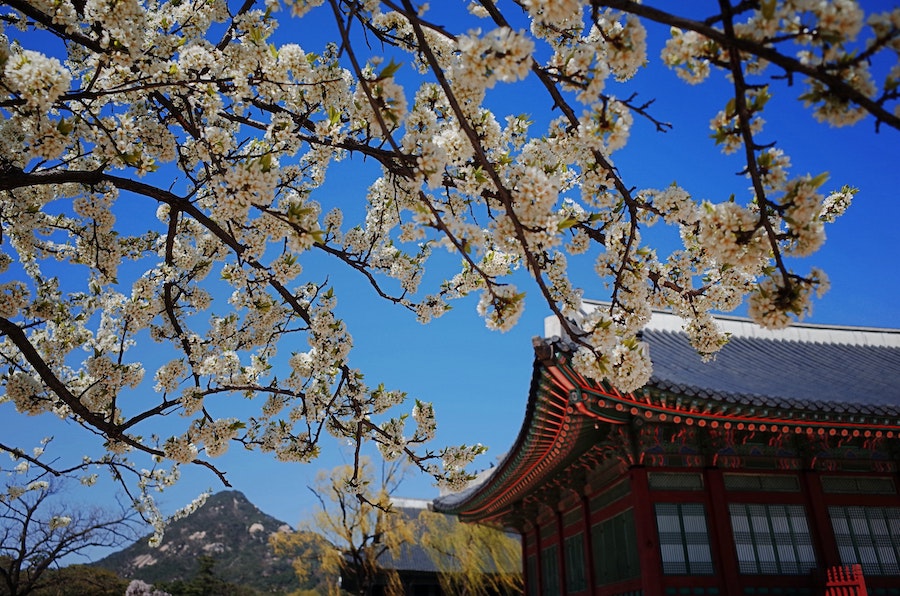
How to get there?
- Address: 161, Sajik-ro, Jongno-gu, Seoul (서울특별시 종로구 사직로 161)
- By Subway: The fastest and most efficient way to get around Seoul is the subway. Considering the importance of the site, there are many subway stops nearby, which will only take a few minutes to walk. Take Line 3, Gyeongbokgung Station (Government Complex-Seoul), exit 5. Or take Line 5, Gwanghwamun Station, exit 2.
- By Bus: Due to its central location there can be some traffic. Taking the subway is the best way to reach Gyeongbokgung Palace. However, from Incheon Airport or outside Seoul, the bus can be a convenient way to get there. From Incheon Airport, take bus # 6011.
Other information
- Opening hours: March-May, September-October 09:00-18:00 / June-August 09:00-18:30 / November-February 09:00-17:00 (closed Tuesdays)
- Admission: Adults 3,000 won / Children 1,500 won
- Website: www.royalpalace.go.kr
Our recommendations
- If you wear a Hanbok (traditional Korean costume) you can enter for free. You can rent a Hanbok at low price here. Besides giving you free access to all palaces, wearing Hanbok is super fun and will give you plenty of photo opportunities.
- To make the most of these five palaces, the city of Seoul has implemented a pass. This is a small notebook with tear-off coupons. To purchase it, simply go to the cash desk at one of these five locations and request a Combination ticket for palaces. It is 10,000 won (5,000 won for children). Which is cheaper than paying for each visit. This pass is valid for three months.
- Another tip: visit the Seoul Palace with a cultural guide. Indeed, nothing better than visiting a palace with a specialist. These tours are free and available in several languages (Korean, English, Chinese, Japanese). Just ask the front desk or check online for free tours.
- Gyeongbokgung, Changdeokgung and Changgyeonggung Palaces offer night tours every year until 10 p.m. Check their respective website for more information. We loved visiting the Palaces at night as the atmosphere is completely different and somewhat magical.
A bit of history about Gyeongbokgung

Gyeongbokgung Palace was the main royal palace of the Joseon dynasty, founded at the coronation of the king Taejo in 1392.
The new King Taejo decide that Hanyang (later Seoul) will become the new capital in 1394. The location was chosen according to the Chinese principle of Fengshui, being located between 2 Mountains. The construction of the Gyeongbokgung Palace ended in 1395.
If the name of the palace indicates a temple under the protection of the heavens, fate however decided otherwise…
In summary, here are the main dates to remember:
- 1592-1598: It is a period of Japanese invasion. During this period the Japanese troops largely destroyed Gyeongbokgung. Following this tragic episode, Changdeokgung, a secondary palace, was rebuilt and served as the main palace for nearly three centuries.
- 1867: Prince Regent Heungseon restores Gyeongbokgung Palace during the reign of King Gojong (1852 – 1919). It then had more than 500 restored buildings, spanning 40 hectares.
- 1910-1945: This is the period of Japanese occupation. The palace is dismantled and a good part of the buildings (80%) are destroyed during the Japanese colonization.
- 1927: the Gwanghwamun gate is removed. To assert their power, Imperial Japan built massive architecture in the front of the palace to house the Japanese general government which blocked the view of the palace.
- 1990-2009: over time, the palace has been restored little by little. It was not until the late 1990s that the imposing Japanese building was demolished. By the end of 2009, an estimated 40% of the structures that existed before had been restored or rebuilt.
- 2009-: South Korea is currently in a new phase of restoration planned over 20 years to restore all the splendor of the site as at its origin.
Things to see at Gyeongbokgung Palace in Seoul
1. Watch the change of guards

The change of guards is such a great experience which we highly recommend if you are visiting Gyeongbokgung. South Korea takes the safeguarding of its culture and heritage very seriously. The guards wear traditional uniforms and weapons in hand. Everything is orchestrated with traditional music played in the background.
The changing of the guard ceremony was first instituted in 1469 during the (short) reign of King Yejong, when day guards changed with those on night duty.
The Royal Guards of the Joseon Dynasty were by definition responsible for guarding as well as patrolling the royal palaces and the city gates. The commander of the gate guards, called Sumunjang, was the military leader who led these royal guards.
- Where: in front of the main Gwanghwamun gate (outer side)
- When: twice a day (except Tuesday), at 11 a.m. and 1 p.m. (for approximately 10 minutes)
If you ever miss the changing of the guards ceremony, there is still the possibility of seeing the guards stationed in front of the door. This is an opportunity to still see the colorful costumes, even if the experience is less captivating
2. Gwanghwamun Gate

You enter the Gyeongbokung Palace Complex through its large main gate, in front of the square bearing the same name, Gwanghwamun.
With Gyeongbokgung Palace being the main palace of the Joseon Dynasty, the gates were built like fortresses with high stone walls and three arched entrances. This is a configuration that was also found in Vietnam. Namely, the central arch is only used by the king while the crown prince (s) and government officials used the side entrances.
The architecture features a double roof, typical of Korea. A bell inside the building was used to announce the time of day. The Gwanghwamun Gate was first rebuilt in 1968, in a “temporary” concrete version, but has since been completely restored, replacing its original structure.
During the Joseon Dynasty, the square in front of Gwanghwamun Gate was used by citizens to gather and express their political opinions. Behind the palace you can see the Blue House, the current residence of the Korean president (equivalent to the White House, but with a blue roof). There is also the American embassy on the other side of the street.Gwanghwamun square is still used today as a place of demonstrations and important political events.
3. Heungnyemun, the 2nd gate

Right after passing through Gwanghwamun Gate you will find the ticket counter on your right. Unless you are wearing a traditional costume (hanbok – rent one here), in which case the entrance if free, buy a ticket before entering the palace.
This is a large large courtyard separating the main gate from the secondary gate called Heungnyemun. This gate was restored to its original state after the colonial Japanese government building was demolished.
Here you get a very good impression of Gyeongbokung Palace already. The contrast from the modernity of the city is impressive. The visit starts here, really. ENJOY!
4. Geunjeongjeon, the throne room
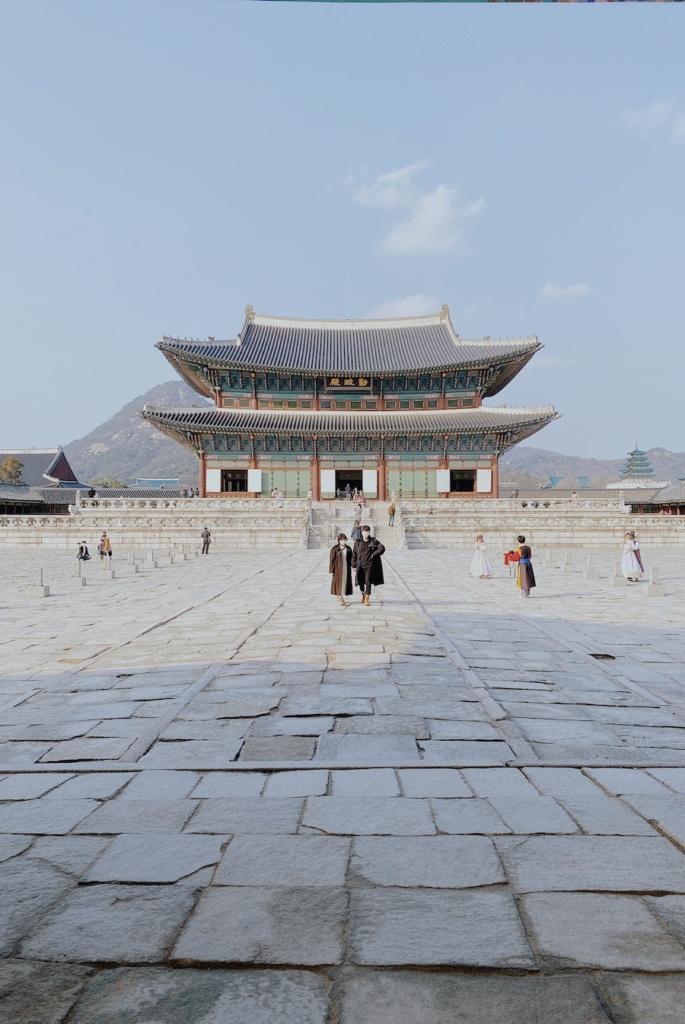
Geunjeongjeon means “diligent government”. It was the throne room of the kings of the Joseon dynasty, to handle important state affairs such as coronations, cabinet meetings, state visits, etc.
The current hall was built in 1867, after being burnt during the Japanese invasion in 1592. Symbolizing the sacred monarchy, it is the great hall of the palace. It is in the middle of a stone-paved square, with standing stones called pumgyeseok (품계석). During the Joseon dynasty, the government had 18 different highly hierarchical ranks. They indicate the position of court officials, lined up here in rank during official functions in Geunjeongjeon.
The Geujeongjeon Hall is accessible by a series of steps decorated with floral motifs carved into the stone. The balustrades are also carved in stone and statues of animals.
The Geujeongjeon room remains quite sober in itself. Almost no furniture despite the large space, but a superb ceiling with a pair of seven-clawed dragons, which symbolize the king and the state. Behind the throne is a painting with a 5 mountain, where the sun and the moon are distributed on both sides.
5. Sajeongjeon Hall
Sajeongjeon served as the king’s main office to manage state affairs. The leaders of Joseon held daily morning assemblies there with the highest officials. There is a table similar to that in the throne room.
One of the buildings in Gyeongbokung Palace also served as a library for the kings, where they studied classic Chinese literature for instance.
6. Gyeonghoeru Pavilion
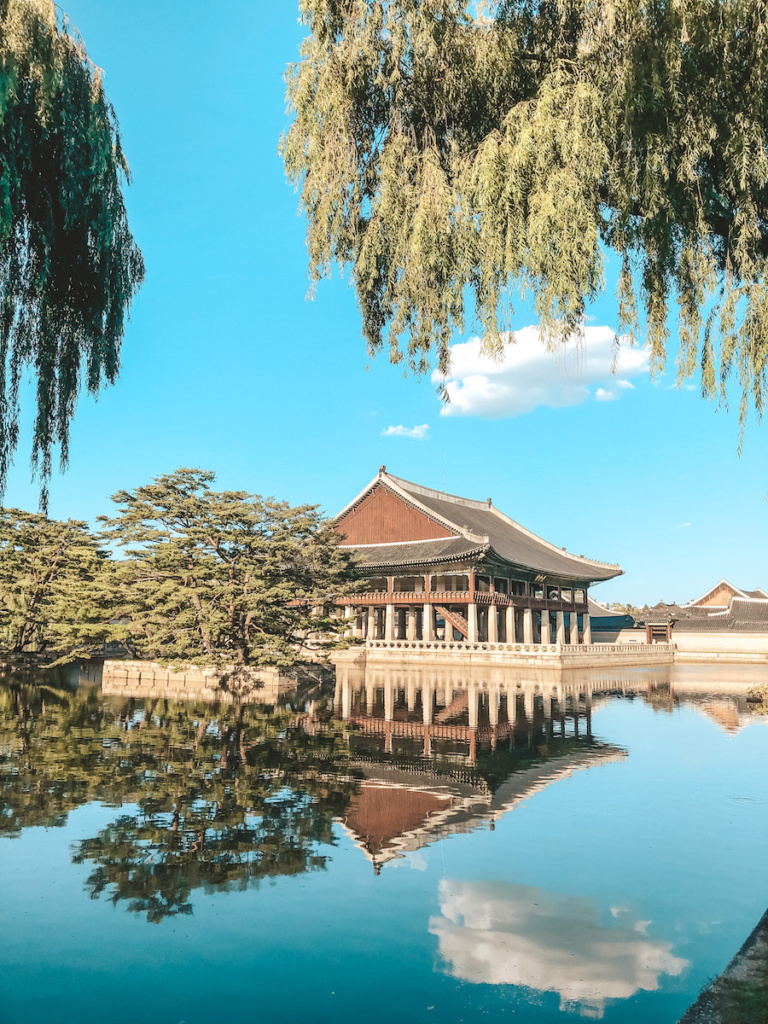
Surrounded by water, Gyeonghoeru pavilion is one of the best spots in Gyeongbokung Palace.
The Gyeonghoeru pavilion served as a royal banquet hall. It was used at important state events, for royal feasts, receptions of foreign diplomats and certain rituals.
The windows of the upstairs rooms frame the magnificent view of Inwangsan Mountain. In addition, the 12 rooms of the pavilion refer to the 12 months of the year while the 24 outer pillars supporting the structure represent the 24 solar terms.
In 1997 a clean-up project revealed two bronze dragon sculptures, resting at the bottom of the mud. Each dragon weighed 66.5 kg and was nearly 5 feet tall. The belief was that the dragon controlled water and therefore rains. So they willingly placed these dragons in the pond to protect the wooden architecture from the fire, but hope for rainfall for a successful harvest.
This pair of dragons is currently on display at the National Palace Museum (on the left after the large Gwanghwamun gate).
The current pavilion was rebuilt in 1867, after completely burning down during the Japanese invasion in 1592. While other palace structures have since re-burned or been destroyed again, this pavilion has at least survived until then.
7. Taewonjeon Hall
Taewonjeon is located at the back of the palace, near the North Gate (Sinmumun).
The main hall of Taewonjeon housed the portrait of King Taejo, founder of the Joseon dynasty. The other buildings around Taewonjeon at the northwest corner of Gyeongbokgung Palace are Binjeon Hall, Honjeon Hall and Yeongjeon Hall. Each had a specific function.
Binjeon Hall is where the deceased royals were dropped off immediately after their deaths. While Honjeon Hall kept the mortuary tablets for two years before moving them to Jongmyo Shrine. Finally, the Yeongjeon Hall was used to display the portraits of the deceased and it is also where the funeral rites took place.
8. Hyangwonjeong Pavilion

Hyangwonjeong Pavilion, was the personal garden of Emperor Gojong and his queen, Myeongseong. Gojong reigned from 1867 to 1907 and was the last king of the Joseon dynasty and first of the only two emperors of the Korean Empire, which collapsed with the colonization of the country by Japan in 1910.
9. Geongcheonggung
Geongcheonggung Palace is another residence for the Kings in order to enjoy their quiet private time. The residence was built in 1873, five years after the reconstruction of Gyeongbokung Palace. Opposite this residence is Hyangwonji Pond, landscaped with the Hyangwonjeong Pavilion in the middle and a wooden bridge connecting it. It is the centerpiece of this garden adjoining the palace, designed to be a place of relaxation, unique to the royal family.
It was here that the King’s wife, Myeongseong, was brutally murdered by the Japanese in 1895 (shortly after the end of the Sino-Japanese War of 1894-1895). This tragic event (known as the “Eulmi Incident”) contrasts sharply with the tranquility of the place and marks the starting point of a strong anti-Japanese feeling, still present today among some Koreans.
It was also in this building that the very first light bulb in the whole kingdom was installed, only 7 years after its invention by Thomas Edison.
10. Jibokjae and National Folk Museum of Korea
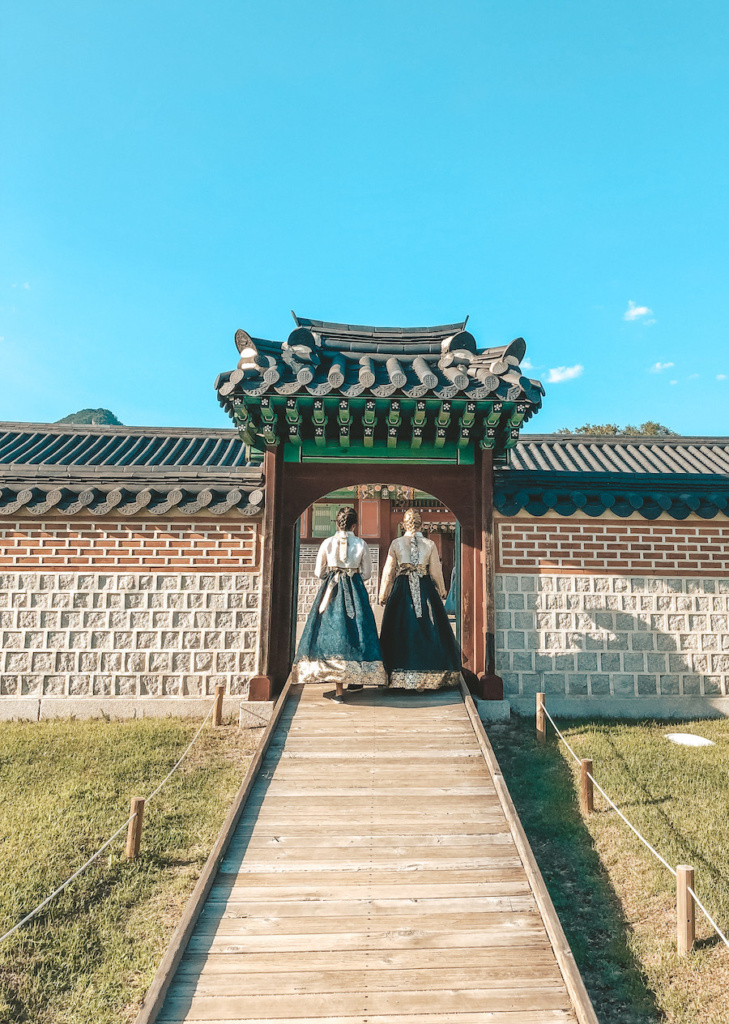
Next to Geongcheonggung Residence is Jibokjae, actually made up of three buildings, with Hyeopgildang and Parujeong Halls. These three structures were originally located in Changdeokgung Palace. They were then transferred to Gyeongbokgung when King Gojong moved from his then residence to the newly renovated palace in 1888. King Gojong used these buildings as a library and reception hall for foreign delegations.
Compared to other buildings, Jibokjae Hall is different because it features Chinese architecture that was considered “modern” at that time.
The National Folk Museum of Korea, recognizable by its pagoda is one of the two museums integrated into the palace (the other being the National Palace Museum of Korea)
11. Jagyeongjeon and Donggung

The Jagyeongjeon Hall served as the residence area for Queen Sinjeong. The hall was built when Gojong’s father Daewongun (then Regent Heungseon) began the reconstruction of Gyeongbokgung Palace. Unfortunately, the building went up in smoke as soon as it was finished…. But the new structure was restored in 1888.
Not far from Jagyeongjeon, is the Donggung residence, for the prince. This residence is to the east of the throne room, which is not completely trivial, because as the sun rises from the east, this palace therefore symbolizes the future ascension of the crown prince who ascends the throne. .
While this configuration was not original to Gyeongbokgung Palace, it was added by King Sejong in 1427.
12. Gangnyeongjeon, Gyotaejeon, Amisan Garden

This area of Gyeongbokung Palace includes the quarters of the king (Gangnyeongjeon) and the queen (Gyotaejeon). The Gangnyeongjeon Hall has been burnt down three times in history, including during the reign of King Sejong in 1397-1450, who instigated it.
It was rebuilt at the end of the 19th century like the rest, but was dismantled to be used as material for the reconstruction of the living quarters of Changdeokgung Palace in 1918. The current building was only rebuilt in 1995, using specifications based on the original plan.
Similar fate for the Queen’s Quarters, with Gyotaejeon Hall being dismantled at the same time. Its materials were used to build the Daejojeon Hall in Changdeokgung Palace.
Finally, the garden of Amisan. Located behind the Queen’s Quarters (Gyotaejeon), Amisan consists of an artificial hill, which symbolizes Mount Emei (located in Sichuan, China). This sacred mountain was then considered the most beautiful and the most mysterious of this time.
Other things to see near Gyeongbokgung
5 Grand Palaces of Seoul

If you are interested in visiting other palaces in Seoul we recommend Changdeokgung and Changgyeonggung which can be visited together as they are side by side. These 2 palaces are actually our favorite ones.
Seoul has 5 Grand Palaces in total, you can discover them in our full post here.
Bukchon Village

Bukchon is a Hanok village in Seoul, located on a hill right beside Gyeongbokgung. The village became famous mainly through Korean dramas. The Hanok village of Bukchon is one of Seoul must-see.
What is particularly pleasant about the Hanok village of Bukchon is its delicious mix: traditional Korean houses with undeniable charm sit against the backdrop of a megalopolis with tall buildings. One will easily notice the N Seoul Tower in the distance, symbol of the South Korean capital.
If you enjoy Hanok villages, we highly recommend a visit to Eunpyeong Hanok Village in Seoul. You can check out our full post here.
Samcheongdong

Samcheongdong is a little neighborhood which is absolutely charming and one of our favorite area in Seoul.
The name “Samcheong” comes from the Chinese “sam”, three and “cheong” for clarity or purity. Indeed, the mountain, the water and the hearts of its inhabitants were considered clear and pure.
During the Joseon period, Samcheongdong was famous for its streams and was considered a good neighborhood to live in.
Today, this district has become a place full of cozy cafes, traditional restaurants and small craft shops. You can also discover many art galleries and the National Museum of Contemporary Art, Samcheongdong being known to be an arts district.
In conclusion
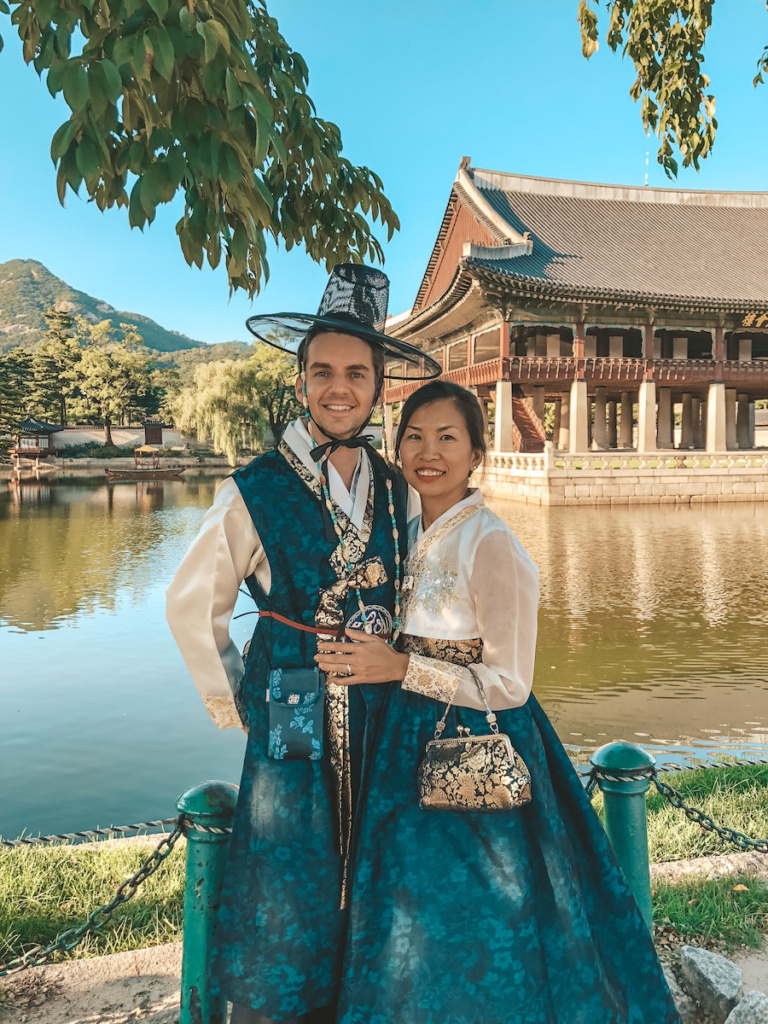
Visiting 1 of Seoul Palaces is always a unique experience. Gyeongbokgung being the biggest and most important one, it should therefore be on your to-do list of things to do in Korea.
If you stay in Seoul for a few days, we recommend the visit of the 5 main Grand Palaces. More information about that here.
We lived in Seoul for 3 years and loved exploring all these beautiful places in Korea. There are many posts about Korea in this blog, you can find them all here.
HAPPY TRAVELING!
Related articles
- CHANGGYEONGGUNG our favorite palace in Seoul
- SOUTH KOREA: some of the most amazing things to do in South Korea
- DEOKSUGUNG PALACE, the most westernized one in Seoul
- JEONJU: the cutest hanok village in Korea
- WHY visiting South Korea
- IHWA MURAL VILLAGE: a visit off the beaten path in Seoul
- IKSEON-DONG: the cutest neighborhood of Seoul
- JEJU: the best island escape from Seoul
- WOLMIDO: the perfect place to escape the busy Seoul
- INSADONG: a must-see area of Seoul
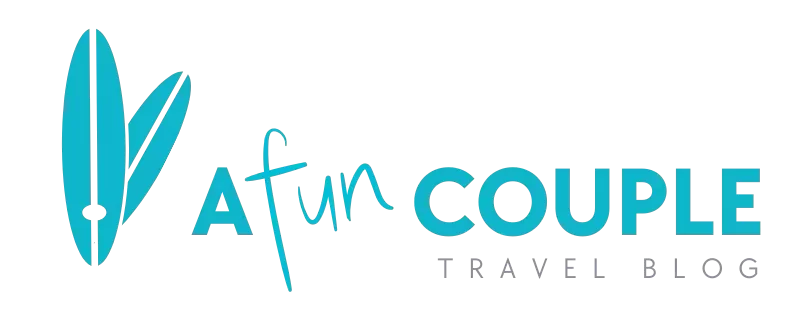
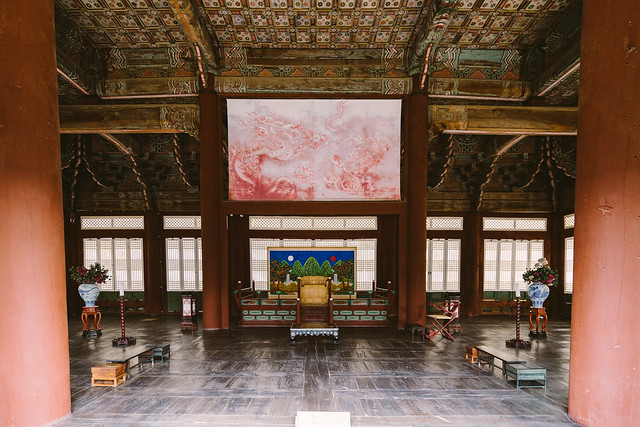


![GUIDE TO KELLIE’S CASTLE NEAR IPOH [MALAYSIA]](https://afuncouple.com/wp-content/uploads/2023/09/Kellie-Castle-near-Ipoh-Malaysia-9-768x576.webp)


![GUIDE TO LIPTON’S SEAT IN HAPUTALE [SRI LANKA]](https://afuncouple.com/wp-content/uploads/2022/09/Liptons-Seat-in-Sri-Lanka-1-768x512.jpg)

![DISCOVER KAMIKOCHI IN THE JAPANESE ALPS [FULL GUIDE]](https://afuncouple.com/wp-content/uploads/2023/01/Guide-for-Kamikochi-1-768x512.jpg)